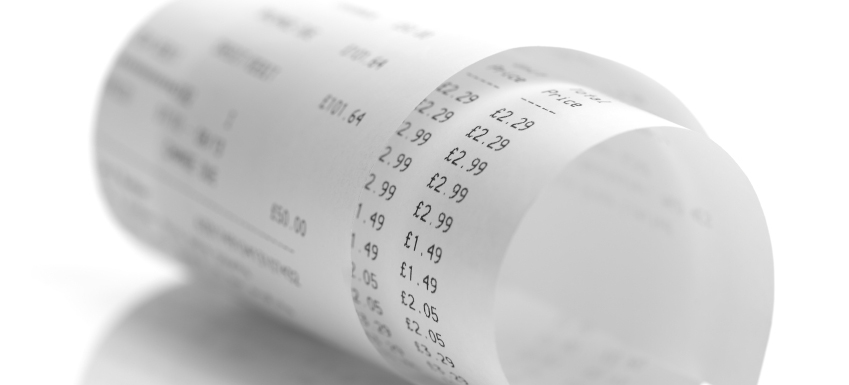There’s BPA in that Receipt Paper
By Suzanne Price.
A Familiar Scene
There you are at checkout, trying to pack up, all the while your baby or toddler is having a fit about something. To keep them quiet and entertained you give them the only thing you have on hand—the store receipt. Many of us have done this, including myself. We witness it at Sprout every day. People figure, what can be the harm in handing my child a piece of paper they can crinkle?
What’s the Harm?
The harm is, much of the receipt paper used by typical retail stores is laden with BPA. The chemical that we’ve avoided in baby bottles and sippy cups (even before it was banned) is what allows thermal printing on receipts. Your babies play with the paper, the chemical rubs off on their hands, and then they put their hands in their mouths, because that’s what babies do.
We are pleased to inform you that all receipt paper used at any Sprout San Francisco location is free of BPA. Please ask about it the next time you are about to hand your child a receipt to play with.
EWG on BPA in Receipt Paper
Please read the below excerpts from the Environmental Working Group’s (EWG) article, “BPA Coats Cash Register Receipts: Tests Find Chemical-Laden Receipts at National Retailers“.
The plastic component bisphenol A (BPA) has been in the headlines nonstop as scientists, health experts and consumers press for a federal ban on food packaging made with this synthetic estrogen, shown to leach readily into infant formula, beverages and canned food. But most Americans are probably unaware that they are regularly exposed to the same endocrine-disrupting chemical in cash register receipts.
Two-fifths of the paper receipts tested by a major laboratory commissioned by Environmental Working Group were on heat-activated paper that was between 0.8 to nearly 3 percent pure BPA by weight. Wipe tests conducted with a damp laboratory paper easily picked up a portion of the receipts’ BPA coating, indicating that the chemical would likely stick to the skin of anyone who handled them. The receipts came from major retailers, grocery stores, convenience stores, gas stations, fast-food restaurants, post offices and automatic teller machines (ATMs).
Major retailers using BPA-containing receipts in at least some outlets included McDonald’s, CVS, KFC, Whole Foods, Walmart, Safeway and the U.S. Postal Service. Receipts from some major chains, including Target, Starbucks and Bank of America ATMs, issued receipts that were BPA-free or contained only trace amounts.
Scientists have not determined how much of a receipt’s BPA coating can transfer to the skin and from there into the body. Possibilities being explored include:
• Oral exposure — BPA moves from receipts onto fingers and then onto food and into the mouth.
• Dermal exposure — BPA from receipts is directly absorbed through the skin into the body.A study published July 11 by Swiss scientists found that BPA transfers readily from receipts to skin and can penetrate the skin to such a depth that it cannot be washed off.
Biomonitoring surveys by the federal Centers for Disease Control and Prevention have found BPA in the bodies of 93 percent of Americans over age 6. EWG analysis of CDC data has found that people who reported working in retail industries had 30 percent more BPA in their bodies than the average U.S. adult, and 34 percent more BPA than other workers. (CDC 2004). As of May 2009, 1 in 17 working Americans — 7 million people — were employed as retail salespersons and cashiers, according to the Bureau of Labor Statistics.
Thermal paper is widely used for point-of-sale receipts, prescription labels, airline tickets and lottery tickets. Thermal printers use paper that is coated with a dye and developer (BPA or an alternative chemical). Heat from the thermal printing head triggers a reaction between the dye and developer, allowing the black print to appear.
Shop Sprout San Francisco and you’ll know everything is free of not just BPA, but the whole Bisphenol Alphabet, as well as all other toxic chemicals. We do the research for you.


